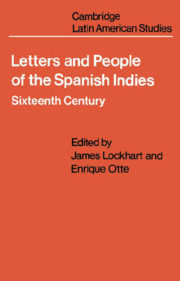Book contents
- Frontmatter
- Contents
- Preface
- Part I Conquest
- Part II The Variety of Life in the Indies
- Part III officials and Clerics
- 29 How a governor operates
- 30 Alarm and drastic remedies: A viceroy's view of New Spain
- 31 The concerns of a judge
- 32 bishop and the governor
- 33 A bishop's affairs
- 34 Franciscans and the Indians
- 35 The Dominican attack
- 36 The Franciscan reply
- 37 The petty administrator
- 38 The parish priest
- Bibliography
- Index
35 - The Dominican attack
from Part III - officials and Clerics
Published online by Cambridge University Press: 06 August 2018
- Frontmatter
- Contents
- Preface
- Part I Conquest
- Part II The Variety of Life in the Indies
- Part III officials and Clerics
- 29 How a governor operates
- 30 Alarm and drastic remedies: A viceroy's view of New Spain
- 31 The concerns of a judge
- 32 bishop and the governor
- 33 A bishop's affairs
- 34 Franciscans and the Indians
- 35 The Dominican attack
- 36 The Franciscan reply
- 37 The petty administrator
- 38 The parish priest
- Bibliography
- Index
Summary
Fray Andres de Moguer, in Mexico City, to the Council of the Indies, 1554
… Consider what sort of indoctrination they can give them! …
In Spanish American secular society there were conflicts between the first conquerors with their large encomiendas, and later arrivals attempting to get some share for themselves. This was just as true in the ecclesiastical world, and first-comers had just as great an initial advantage. Myths formed around the Twelve, the first party of Franciscans to arrive in Mexico, and the order quickly established itself in the largest towns of the central part of the country. The later-coming Dominicans and Augustinians were forced into relatively peripheral or secondary situations. They resented it, protested, and carried on various kinds of skirmishes until finally, again as in the secular world, some accommodations were made, though overall Franciscan predominance was retained.
The Dominicans were the greatest scourge of the Franciscans, not only because they were second in seniority and strength, but because of the propensities of the two orders. The Franciscans were pragmatic builders, converters and baptizers; the Dominicans, the Order of Preachers, were intellectuals inclined to higher education, thorough preparation, and doctrinaire positions. Thus power politics and conviction coincided in their constant complaint that Franciscan ambition and compromise were leading to the dilution of Christianity through haste; time should be taken to instruct both ecclesiastics and Indians before general application of the sacraments, the ratio of ecclesiastic personnel to Indians should be reduced, etc. All of this both suited the Dominicans’ taste, and would hamstring their rivals until they could catch up with them. Very basic human attributes often surface in these debates. Note the portrait of fray Pedro de Gante, so different from his elaborate humility in Letter 34. A childlike Franciscan pride in numbers, and a responding childlike Dominican jealousy, are prime factors in the continuing debates. of course these things varied from region to region; in Peru it was the Dominicans who were first and strongest. The characteristics of the orders, however, are relatively universal, and thus the whole Dominican-dominated body in Peru was more doctrinaire, less energetic in building and teaching.
- Type
- Chapter
- Information
- Letters and People of the Spanish IndiesSixteenth Century, pp. 215 - 217Publisher: Cambridge University PressPrint publication year: 1976



